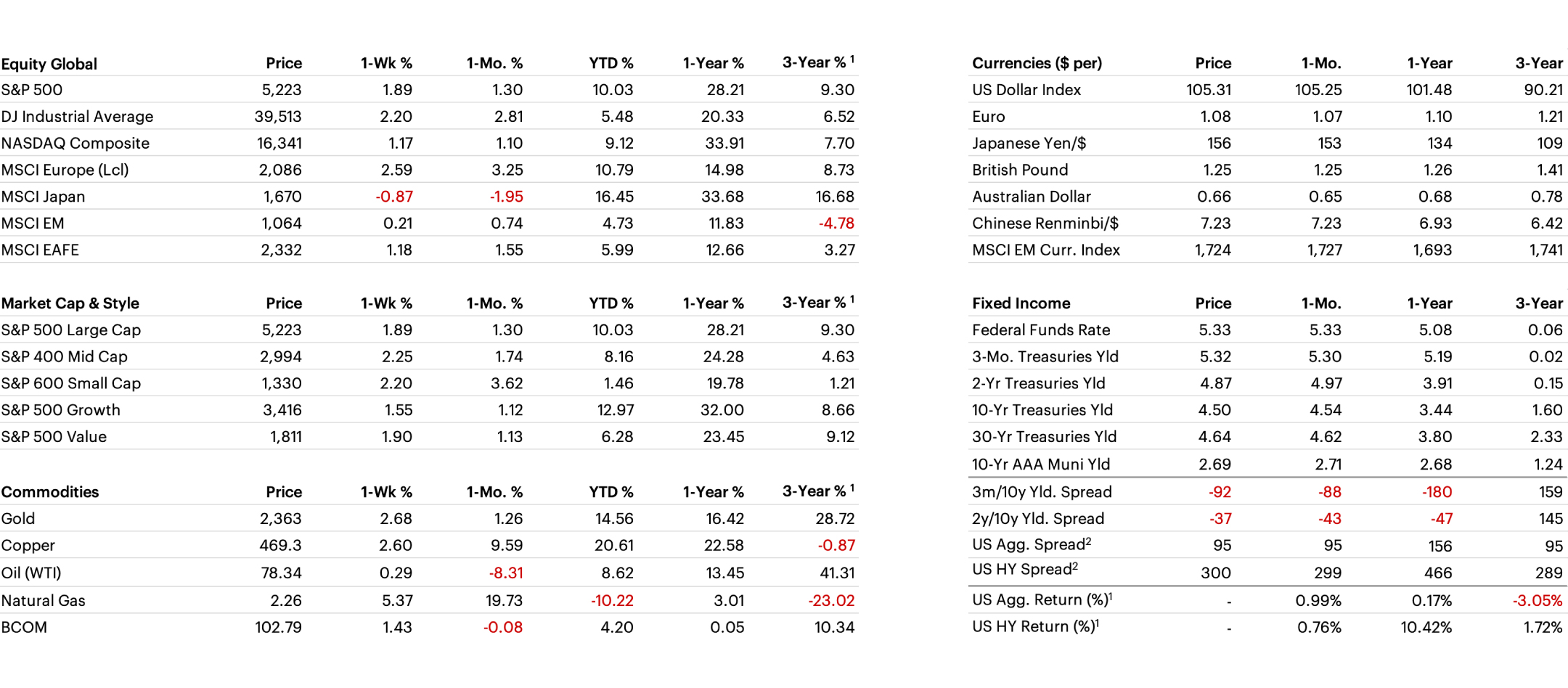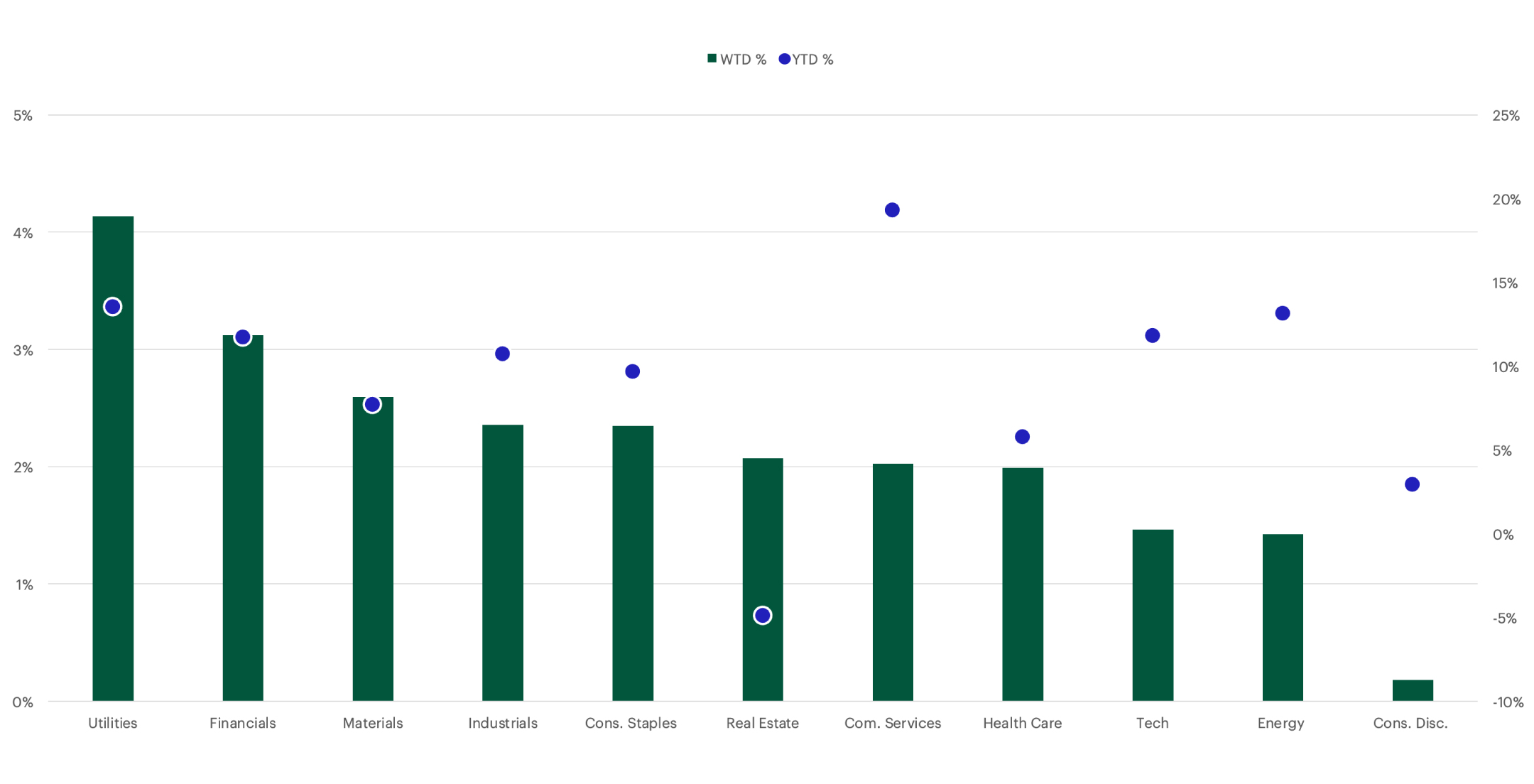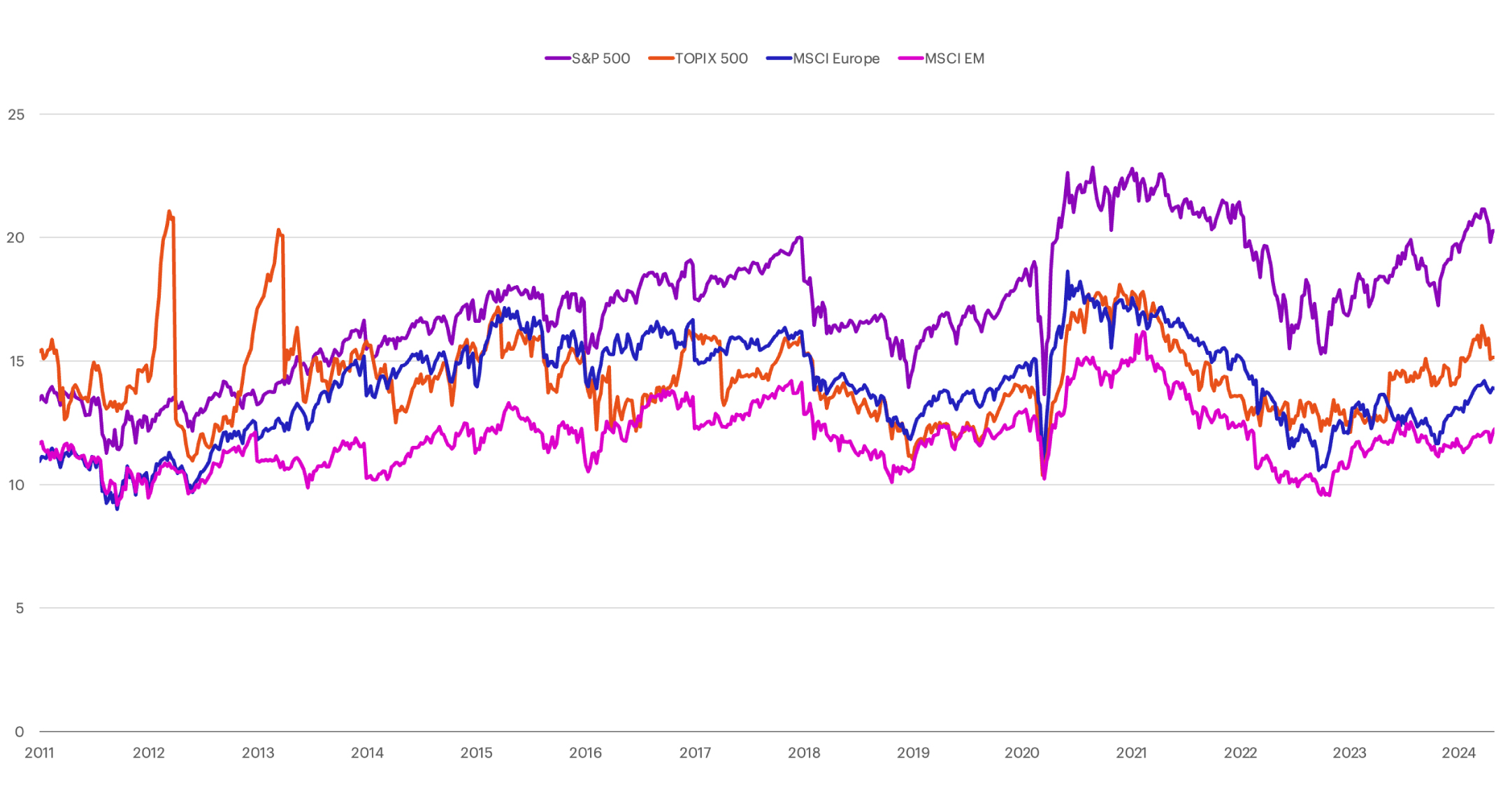Market Dashboard
New every Monday with last week’s recap and notes on the week ahead.
Last update: 5/13/2024
US equities: Stocks were higher in a relatively quiet week.
- The S&P 500 Index increased 1.85% last week.
- The Nasdaq Composite Index rose 1.14%.
- The small-cap Russell 2000 Index was up 1.18%.
- All S&P 500 sectors were higher for the week. Utilities and Financials were the best performing sectors, while Energy and Consumer Discretionary performed worst.
- After briefly spiking above 19 in April, the CBOE Volatility Index (VIX), known as the stock market’s “fear gauge,” retreated to a three-month low last week, ending Friday at 12.55.
US fixed income: Treasury yields inched lower.
- The two-year Treasury yield increased 5 basis points to 4.87%.
- The 10-year Treasury yield decreased 1 basis point to 4.50%.
- The U.S Treasury Department successfully auctioned $125 billion in notes and bonds last week, but worries linger about the sustainability of the U.S. budget deficit.
Commodities and currencies: Gains for the greenback, oil and gold.
- The US dollar was stronger last week.
- The Japanese yen continued to weaken, despite recent government intervention to support the currency.
- WTI crude oil rose 0.2%.
- Gold increased 2.8%.
Key economic data: Consumer moods sour, jobless claims rise.
- The University of Michigan’s consumer sentiment index for May came in at 67.4, down sharply from 77.2 in April and well below consensus estimates of 76.2.
- Consumers’ one-year and five-year economic outlooks both fell, as did their view of buying conditions.
- Meanwhile, consumers’ one-year inflation expectation climbed to 3.5%, from 3.2% the prior month.
- Initial jobless claims rose to 231,000 for the week ended May 4, up 22,000 from the previous week and higher than consensus estimates of 212,000. This is the highest level since August 2023.
- Continuing jobless claims were slightly higher, at 1.785 million.
- An update to the Federal Reserve’s Senior Loan Officer Opinion Survey showed tighter lending standards and weaker demand for business lending in the first quarter.
Corporate earnings: First-quarter (Q1) S&P 500 earnings up 5.4%.
- With 92% of S&P 500 companies having reported Q1 earnings as of May 10:
- Earnings per share were up 5.4% year-over-year, according to FactSet.
- 78% of companies had beaten consensus earnings expectations.
- Only 59% of companies had surpassed consensus sales expectations.
Global markets: Chinese stocks surge, UK exits recession.
- Chinese equities continued to gain momentum; the MSCI China Index is up about 15% in the last three weeks.
- The UK exited its brief recession, with GDP expanding at 0.6% quarter-over-quarter in Q1, marking the fastest growth rate in over two years.
Cross-Asset Performance Table
Returns and prices of the most popular indices and assets as of 5/10/24

1) Annualized 3-year % return. 2) Option Adjusted Spread (OAS): OAS is a measurement of the spread of a fixed income security rate and the risk-free rate of return, which is adjusted to take into account an embedded option. Equity risk premium is the excess return that an individual stock or the overall stock market provides over a risk-free rate. The risk-free rate represents the interest an investor would expect from an absolutely risk-free investment over a specified period of time.
S&P 500 Sector Performance
Utilities and Financials were the best performing S&P 500 sectors last week, while Energy and Consumer Discretionary performed worst

Russell US Equity Style Performance
Growth has significantly outperformed value

US Equity Valuation
S&P 500 Equity Risk Premium
Bonds continue to appear attractive relative to equities

P/E Relative to Rest of World
The S&P 500 remains expensive relative to the rest of the world

US Fixed Income Valuation
The 10-year Treasury yield decreased 1 bp to 4.50% and the two-year Treasury yield increased 5 bps to 4.87% last week

†Interest Rate Volatility as measured by ICE BofAML Option Volatility Estimate Index (MOVE); *Mortgage-backed securities (MBS) are debt obligations that represent claims to the cash flows from pools of mortgage loans, most commonly on residential property. Mortgage loans are purchased from banks, mortgage companies, and other originators and then assembled into pools by a governmental, quasi-governmental, or private entity; **Options Adjusted Spread (OAS): A measurement of the spread of a fixed income security rate and the risk-free rate of return, which is adjusted to take into account an embedded option
Latest Economic Data
Initial jobless claims rose to 231,000 for the week ended May 4, up 22,000 from the previous week and higher than consensus estimates of 212,000. This is the highest level since August 2023

Sources: Bloomberg, FactSet, Morgan Stanley Wealth Management Global Investment Committee
The Week Ahead
- NFIB Small Business Optimism Index at 6:00 AM ET
- US PPI YoY at 8:30 AM ET
- Home Depot Reports Earnings
- Empire State Manufacturing Survey at 8:30 AM ET
- US CPI YoY at 8:30 AM ET
- US Retail Sales at 8:30 AM ET
- US Business Inventories at 10:00 AM ET
- NAHB/Wells Fargo Housing Market Index at 10:00 AM ET
- Cisco Systems Reports Earnings
- US Initial Jobless Claims at 8:30 AM ET
- US Continuing Claims at 8:30 AM ET
- US Housing Starts at 8:30 AM ET
- US Building Permits at 8:30 AM ET
- Philadelphia Fed Survey at 8:30 AM ET
- US Industrial Production at 9:15 AM ET
- US Capacity Utilization at 9:15 AM ET
- China Retail Sales at 10:00 PM ET
- China Industrial Production at 10:00 PM ET
- Walmart Reports Earnings
- Deere Reports Earnings
- Under Armour Reports Earnings
- Conf. Board US Leading Economic Index at 10:00 AM ET
Index benchmarks
Cross-Asset Performance
S&P 500: A market capitalization-weighted index of 500 widely held stocks often used as a proxy for the stock market. It measures the movement of the largest issues. Standard and Poor's chooses the member companies for the 500 based on market size, liquidity and industry group representation. Included are the stocks of industrial, financial, utility, and transportation companies. Since mid-1989, this composition has been more flexible and the number of issues in each sector has varied. The returns presented for the S&P 500 are total returns, including the reinvestment of dividends each month.
Dow Jones Industrial Average: Computed by summing the prices of the stocks of 30 companies and then dividing that total by an adjusted value—one which has been adjusted over the years to account for the effects of stock splits on the prices of the 30 companies. Dividends are reinvested to reflect the actual performance of the underlying securities.
NASDAQ Composite: Measures the performance of all issues listed in the NASDAQ Stock Market, except for rights, warrants, units, and convertible debentures. Morningstar reports the NASDAQ Composite as a price return.
MSCI Europe IMI: This index captures large, mid and small cap representation across 16 Developed Markets countries in Europe. With 1,372 constituents, the index covers approximately 99% of the free float-adjusted market capitalization across the Developed Markets countries of Europe.
MSCI Japan IMI: This index is designed to measure the performance of the large, mid and small cap segments of the Japan market. With 1,134 constituents, the index covers approximately 99% of the free float-adjusted market capitalization in Japan.
MSCI EM (Emerging Markets) Index: A free float-adjusted market-capitalization index that is designed to measure equity market performance of emerging markets. The MSCI Emerging Markets Index consists of the following 23 emerging market country indexes: Brazil, Chile, China, Colombia, Czech Republic, Egypt, Greece, Hungary, India, Indonesia, Korea, Malaysia, Mexico, Peru, Philippines, Poland, Qatar, Russia, South Africa, Taiwan, Thailand, Turkey and United Arab Emirates. For more information, visit the MSCI web site.
MSCI EAFE (Europe, Australasia, Far East) Index: A free float-adjusted market-capitalization index that is designed to measure the equity market performance of developed markets, excluding the U.S. and Canada. The MSCI EAFE Index consists of the following 21 developed market country indexes: Australia, Austria, Belgium, Denmark, Finland, France, Germany, Hong Kong, Ireland, Israel, Italy, Japan, the Netherlands, New Zealand, Norway, Portugal, Singapore, Spain, Sweden, Switzerland, and the United Kingdom. For more information, visit the MSCI website.
S&P 400 Index: This index provides investors with a benchmark for mid-sized companies. The index measures the performance of mid-sized companies, reflecting the distinctive risk and return characteristics of this market segment.
S&P 600 Index: This index measures the small-cap segment of the U.S. equity market. The index is designed to track companies that meet specific inclusion criteria to ensure that they are liquid and financially viable.
S&P 500 Growth: This index is a style-concentrated index designed to track the performance of stocks that exhibit the strongest growth characteristics by using a style-attractiveness-weighting scheme.
S&P 500 Value: This index is a style-concentrated index designed to track the performance of stocks that exhibit the strongest value characteristics by using a style-attractiveness-weighting scheme.
Bloomberg Commodity Index: Made up of 22 exchange-traded futures on physical commodities. The index currently represents 20 commodities, which are weighted to account for economic significance and market liquidity.
US Trade-Weighted Dollar Index: A weighted average of the foreign exchange value of the US dollar against a subset of the broad index currencies that circulate widely outside the US.
MSCI Emerging Markets Currency Index: sets the weights of each currency equal to the relevant country weight in the MSCI Emerging Markets Index.
Bloomberg US Aggregate Index: The US Aggregate Index covers the dollar-denominated investment-grade fixed-rate taxable bond market, including Treasuries, government-related and corporate securities, MBS pass-through securities, asset-backed securities, and commercial mortgage-based securities. These major sectors are subdivided into more specific sub-indices that are calculated and published on an ongoing basis. Total return comprises price appreciation/depreciation and income as a percentage of the original investment. This index is rebalanced monthly by market capitalization.
Bloomberg US Corporate High Yield Bond Index: This index is composed of fixed-rate, publicly issued, non-investment grade debt.
S&P Sector Performance
The S&P 500 Consumer Discretionary sector comprises those companies included in the S&P 500 that are classified as members of the consumer discretionary sector.
The S&P 500 Consumer Staples sector comprises those companies included in the S&P 500 that are classified as members of the consumer staples sector.
The S&P 500 Energy sector comprises those companies included in the S&P 500 that are classified as members of the energy sector.
The S&P 500 Financials sector comprises those companies included in the S&P 500 that are classified as members of the financial sector.
The S&P 500 Health Care sector comprises those companies included in the S&P 500 that are classified as members of the health care sector.
The S&P 500 Industrials Sector comprises those companies included in the S&P 500 that are classified as members of the industrials sector.
The S&P 500 Information Technology Sector comprises those companies included in the S&P 500 that are classified as members of the information technology sector.
The S&P 500 Materials Sector comprises those companies included in the S&P 500 that are classified as members of the materials sector.
The S&P 500 Communications Services Sector comprises those companies included in the S&P 500 that are classified as members of the telecommunications services sector.
The S&P 500 Utilities Sector comprises those companies included in the S&P 500 that are classified as members of the utilities sector.
The S&P 500 Real Estate Sector comprises those companies included in the S&P 500 that are classified as members of the real estate sector.
US Equity Style Performance
Weekly and monthly style performance charts use Russell 1000, Russell Mid Cap, and Russell 2000 style indexes to represent large cap, mid cap, and small cap respectively.
Russell 1000: Consists of the 1000 largest companies within the Russell 3000 index. Also known as the Market-Oriented Index, because it represents the group of stocks from which most active money managers choose. The returns we publish for the index are total returns, which include reinvestment of dividends. Frank Russell Company reports its indexes as one-month total returns.
Russell 1000 Growth: Market-capitalization weighted index of those firms in the Russell 1000 with higher price-to-book ratios and higher forecasted growth values. The Russell 1000 includes the largest 1000 firms in the Russell 3000, which represents approximately 98% of the investable US equity market.
Russell 1000 Value: Market-capitalization weighted index of those firms in the Russell 1000 with lower price-to-book ratios and lower forecasted growth values. The Russell 1000 includes the largest 1000 firms in the Russell 3000, which represents approximately 98% of the investable US equity market.
Russell 2000: Consists of the smallest 2000 companies in the Russell 3000 Index, representing approximately 7% of the Russell 3000 total market capitalization. The returns we publish for the index are total returns, which include reinvestment of dividends.
Russell 2000 Growth: Market-weighted total return index that measures the performance of companies within the Russell 2000 Index having higher price-to-book ratios and higher forecasted growth values. The Russell 2000 Index includes the 2000 firms from the Russell 3000 Index with the smallest market capitalizations. The Russell 3000 Index represents 98% of the of the investable US equity market.
Russell 2000 Value: Market-weighted total return index that measures the performance of companies within the Russell 2000 Index having lower price-to-book ratios and lower forecasted growth values. The Russell 2000 Index includes the 2000 firms from the Russell 3000 Index with the smallest market capitalizations. The Russell 3000 Index represents 98% of the of the investable US equity market.
Russell Midcap: Measures the performance of the 800 smallest companies in the Russell 1000 Index, which represent approximately 25% of the total market capitalization of the Russell 1000 Index. As of the latest reconstitution, the average market capitalization was approximately $4.0 billion; the median market capitalization was approximately $2.9 billion. The largest company in the index had an approximate market capitalization of $12 billion.
Russell Midcap Growth: Market-weighted total return index that measures the performance of companies within the Russell Midcap Index having higher price-to-book ratios and higher forecasted growth values. The Russell Midcap Index includes firms 201 through 1000, based on market capitalization, from the Russell 3000 Index. The Russell 3000 Index represents 98% of the of the investable U.S. equity market.
Russell Midcap Value: Market-weighted total return index that measures the performance of companies within the Russell Midcap Index having lower price-to-book ratios and lower forecasted growth values. The Russell Midcap Index includes firms 201 through 1000, based on market capitalization, from the Russell 3000 Index. The Russell 3000 Index represents 98% of the of the investable U.S. equity market.
P/E Relative to Rest of World
TOPIX: This free-floated-adjusted index tracks all domestic companies of the exchange’s First Section.
US Fixed Income Valuation
ICE BofAML Option Volatility Estimate Index (MOVE): A yield curve-weighted index of the normalized implied volatility on one-month treasury option.
How can E*TRADE from Morgan Stanley help?
Futures
Like options, futures let you lock in a price now for an investment you’ll buy in the future. They cost much less than the actual investment, so you can control a large contract with a relatively small amount of capital.
Premium Savings Account
Boost your savings with 4.25% APY1
With rates 9X the national average2, plus FDIC protection up to $500,0003, and more.
Hedging with gold
Discover ways to diversify into a precious metal that many investors consider a potential safe when the economy slumps.
Emerging China
Find opportunities to invest in funds focused on China to potentially benefit from the country's ongoing economic and per capita income growth.